|
 Pluteus readiarum Pluteus readiarum
SynonymsEntoloma placidum
Agaricus placidus
Leptonia placida
BiostatusPresent in region - Indigenous. Endemic
Images (click to enlarge)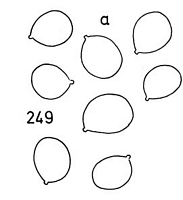
Caption: 249-Pluteus readii [Entoloma placidum]: a. spores. | 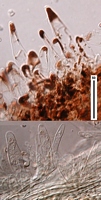
Caption: upper pilocystidia and lower caulocystidia
Owner: J.A. Cooper | 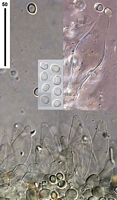
Caption: upper pleurocystidium and spores, lower cheilocystidia
Owner: J.A. Cooper | 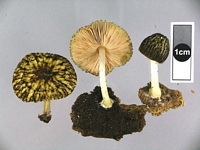
Owner: J.A. Cooper | 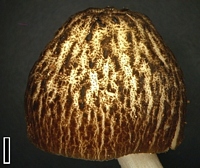
Caption: scale=2mm
Owner: J.A. Cooper | 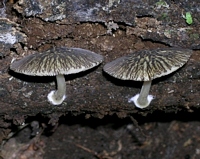
Owner: J.A. Cooper | 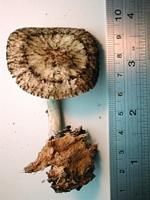
Caption: fruitbody
Owner: J.A. Cooper | 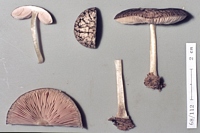
Caption: ZT68-112: Pluteus readiarum
Owner: Egon Horak | 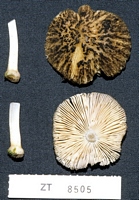
Caption: ZT8505: Pluteus readiarum
Owner: Egon Horak | 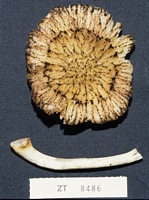
Caption: ZT8486: PLUTEUS READIARUM
Owner: Egon Horak | 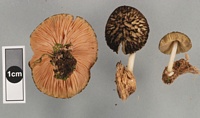
Owner: J.A. Cooper | 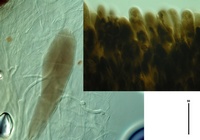
Caption: cap cells and terminal elements
Owner: J.A. Cooper | 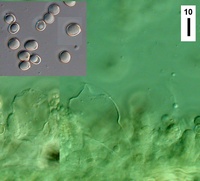
Caption: spores and cheilocystidia
Owner: J.A. Cooper | 
Caption: top: cap hyphae (tufts). Bottom: cheilocystidia.
Owner: J.A. Cooper | 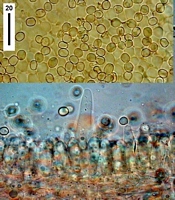
Caption: Top: spores. Bottom: pleurocystidia and basidia.
Owner: J.A. Cooper | 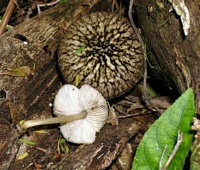
Owner: J.A. Cooper | 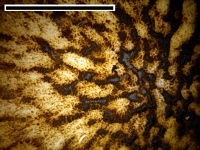
Caption: cap. Scale = 1cm
Owner: J.A. Cooper | 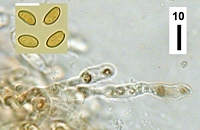
Caption: cap hyphae and spores
Owner: J.A. Cooper | 
Owner: J.A. Cooper | 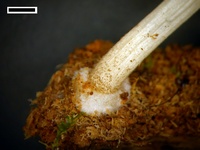
Caption: scale=2mm.
Owner: J.A. Cooper | 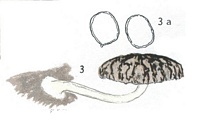
Caption: Plate 3: 3, Pluteus readii, x 1 ;3a, spores, x 2000
Owner: PDD | 
Caption: Fig. 2: 2a, Pluteus readii, pleurocystidium; 2b, cystidia of gill-edge; 2c, hyphal endings of cuticle with dark brown contents. All x 500.
Owner: PDD | 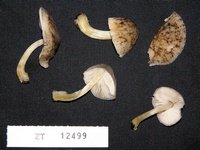
Caption: ZT12499
Owner: E. Horak: © Creative Commons Attribution-Noncommercial 3.0 New Zealand | 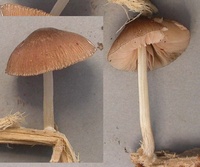
Owner: P. Leonard | 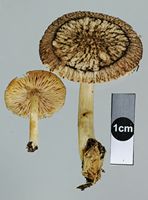
Owner: J.A. Cooper |
Article: Horak, E. (1971). A contribution towards the revision of the Agaricales (Fungi) from New Zealand. New Zealand Journal of Botany 9(3): 403-462 (http://www.rsnz.org/publish/abstracts.php).
Notes: Entoloma placidum (Fries) (11,16,27) Fig. 21 = Pluteus readii Stevenson
The examined material (COLENSO b 1204) agrees with this native Pluteus (see
there) in all characters.
Article: Stevenson, G. (1962). The Agaricales of New Zealand: II. Kew Bulletin 16(1): 65–74.
Description: Pileus 3-3.5 cm. diam., convex, yellow-fawn overlain by a dark-brown velvety, fibrillose network; flesh pale yellow-fawn. Gills free, crowded, pink with whitish margins. Stipe 4 cm. x 3-4 mm., silky-fibrillose, pale yellow, grey tinge at top, bulbous base surrounded by white mycelium. Spores 5 x 6um, print pink. Pleurocystidia not very numerous, pyriform with or without pinhead; balloon cystidia on gill edge 15 x 50um; hyphal endings of pileus 20 x 60-70um, colourless, overlain by a partial palisade of large hyphal endings up to 150 x 25um with dark-brown contents, which constitute the dark velvety fibrils.
Habitat: on standing dead ribbonwood, Nelson, 15.1 1. 1958, D. & L. Read; on fallen tawa, Levin, 5.9.1955, Stevenson
Article: Massee, G.E. (1899) [1898]. The fungus flora of New Zealand. Transactions and Proceedings of the New Zealand Institute 31: 282–349 Wellington:.
Description: Pileus 2-6 cm. across, flesh thin, campanulate, then convex, not striate, the blackish disc
densely downy, the remainder covered with blackish fibrils or squamules on a greyish-white
ground, squamules arranged concentrically when old; gills adnexed, very broad behind, not
ventricose, crowded, whitish, as is also the margin; stem 5-8 cm. long, 3 mm. thick, equal,
very rigid, having white meal at the slightly thickened apex, and with black points or
squamules when seen under a lens, remainder glabrous, even, dark-blue or blackish-blue.
Habitat: On trunks or on the ground.
Distribution: New Zealand. Europe.
Notes: Distinguished from Leptonia lampropoda by the squamulose pileus and the minute black
points on the upper part of the stem.
|